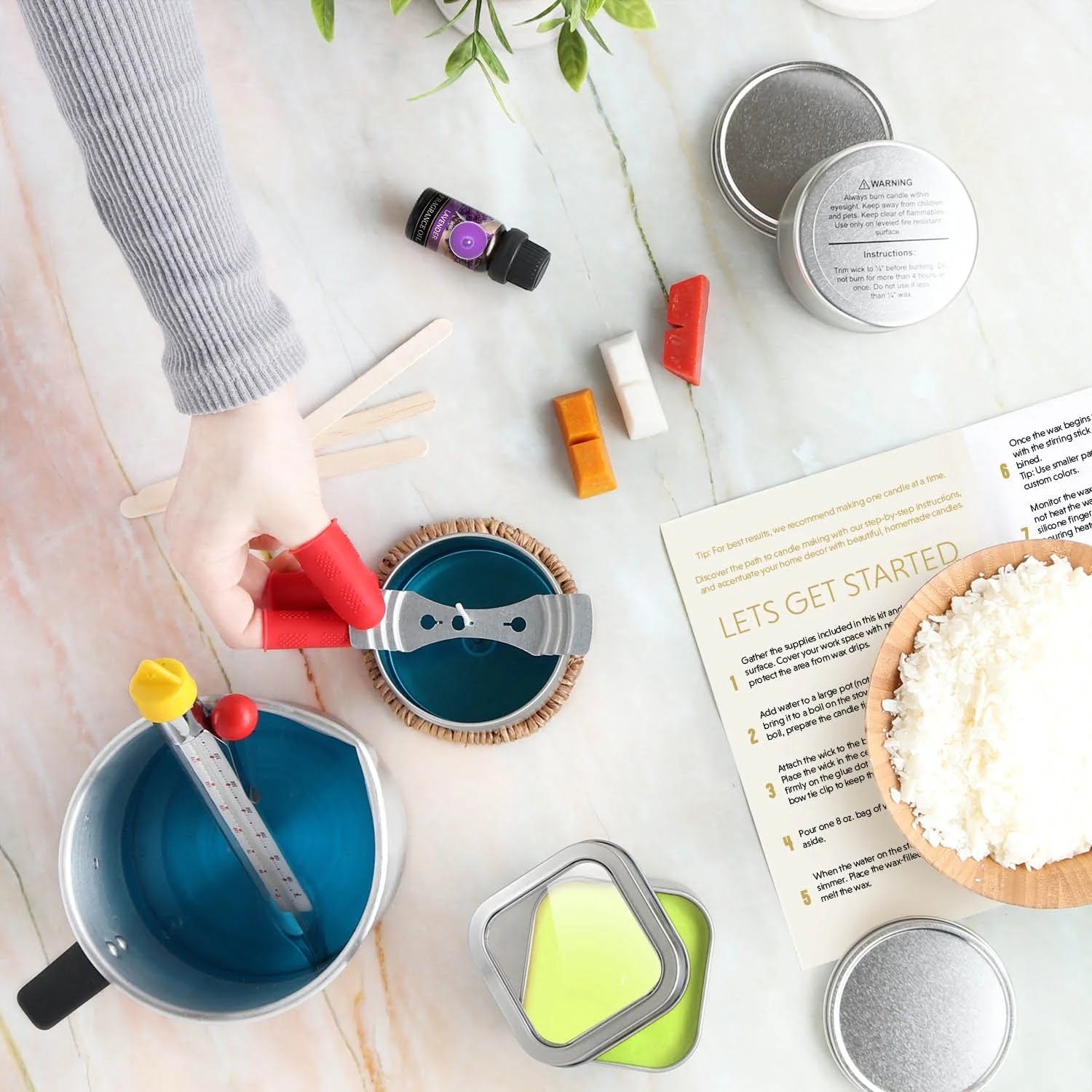Are you interested in learning the art of making perfect votive candles? Whether you’re a seasoned candle maker or a beginner looking to explore a new craft, understanding the importance of achieving flawless votive candles is essential. In this article, we will guide you through the process of creating beautiful and high-quality votive candles right in the comfort of your own home.
Making perfect votive candles requires attention to detail and knowledge of the essential materials and tools needed for the process. From selecting the right wax to choosing the perfect fragrance and dye, every step plays a crucial role in creating a stunning end product. Additionally, understanding how to troubleshoot common issues and practicing safety techniques are vital aspects of candle making that will be explored in this comprehensive guide.
Join us as we delve into the world of votive candle making, exploring different types of wax, pouring processes, decoration and packaging ideas, as well as safety tips. By the end of this article, you’ll be equipped with all the necessary information to create your own flawless votive candles that are perfect for gifting, decorating, or even selling. So let’s get started on your journey to mastering the art of making perfect votive candles.
Essential Materials and Tools
When it comes to making perfect votive candles, having the right materials and tools is essential. Without the proper supplies, achieving a flawless and high-quality product can be challenging. Whether you are a beginner or an experienced candle maker, having a comprehensive list of must-have items will ensure that you are equipped to create beautiful votive candles every time.
Here is a comprehensive list of essential materials and tools for making votive candles:
Materials:
Tools:
1. Double boiler or melting pot: This will be used for melting the wax without direct heat to prevent scorching.
2. Pouring pitcher: A dedicated container for pouring melted wax into candle molds.
3. Stirring utensils: Stainless steel spoons or stirring sticks for blending fragrance oils and dyes into the melted wax.
4. Wick trimmer: To trim wicks to the appropriate length before lighting the candle.
5. Heat gun or blow dryer: Used to smooth out any imperfections on the surface of the candle after it has cooled.
By having all these essential materials and tools on hand, you are setting yourself up for success in making perfect votive candles. Be sure to source high-quality materials from reputable suppliers to ensure the best results in your candle making endeavors. With the right supplies at your disposal, you’ll be well-equipped to create beautiful votive candles that burn evenly and emit a delightful fragrance.
Choosing the Right Wax
Paraffin wax is a popular choice for making votive candles due to its affordability and ease of use. It has a high fragrance load capacity, which means it can hold a large amount of scent, making it ideal for scented votive candles. However, paraffin wax does produce some soot when burned, so it might not be the best choice if you are looking to create clean-burning candles.
Soy wax is a natural alternative to paraffin wax and is known for producing clean-burning candles with minimal soot. It is also biodegradable and easy to clean up if spilled. Soy wax votive candles have a creamy appearance and can hold fragrances well, making them a great choice for those who prefer eco-friendly options.
Beeswax is another natural option that has a sweet honey-like aroma and produces long-lasting, bright flames. However, beeswax can be more expensive than other types of wax and may require special handling during the melting process.
In summary, choosing the right type of wax is essential in creating high-quality votive candles. Each type of wax has its own advantages and considerations, so it’s important to consider factors such as fragrance load capacity, burn cleanliness, cost, and environmental impact when selecting the best option for your votive candle-making project.
| Wax Type | Qualities |
|---|---|
| Paraffin Wax | Affordable, high fragrance load capacity; produces soot when burned |
| Soy Wax | Clean-burning, minimal soot; eco-friendly option with good fragrance retention |
| Beeswax | Natural option with sweet aroma; long-lasting flames but can be more expensive |
Scent and Color
When it comes to making perfect votive candles, selecting the right fragrance and dye is crucial in creating a product that is not only visually appealing but also offers a pleasurable sensory experience. The scent and color of votive candles can set the mood and ambiance for any setting, making them an essential aspect of candle-making.
The first step in selecting the perfect fragrance for your votive candles is to consider the purpose or theme of the candle. For example, if you are creating candles for relaxation, you may want to opt for soothing scents like lavender or vanilla. On the other hand, if you are making candles for a celebratory event, such as a wedding or birthday party, you might choose more festive and uplifting scents like citrus or floral fragrances.
In addition to choosing the right fragrance, selecting the perfect dye color for your votive candles is equally important. The color of a candle can evoke certain emotions or enhance the visual appeal of a space. For instance, warm colors like red or orange can create a cozy and inviting atmosphere, while cool colors like blue or green can promote a sense of calm and tranquility.
When making votive candles, experimenting with different combinations of scents and colors can add depth and uniqueness to your creations. By carefully selecting the perfect fragrance and dye for your votive candles, you can elevate your candle-making skills and create products that are not only visually stunning but also offer an unforgettable olfactory experience for those who enjoy them.
The Pouring Process
Preparing Your Workstation
Before you start pouring the wax for your votive candles, it’s important to ensure that your workstation is clean and organized. Clear a space on a flat, stable surface where you can comfortably work without the risk of any spills or accidents. Gather all the necessary materials and tools, such as the wax, wicks, fragrance oils, dye, pouring pitcher, and thermometer, and have them within reach.
Heating and Melting the Wax
Once your workstation is set up, begin by heating and melting the wax in a double boiler or melting pot. It’s crucial to use a reliable thermometer to monitor the temperature of the wax as different types of wax require specific melting points. Overheating or underheating the wax can result in poor-quality votive candles, so it’s important to follow the recommended temperature guidelines for the type of wax you are using.
Pouring Techniques
When it comes time to pour the melted wax into your votive candle molds, it’s essential to do so slowly and carefully to achieve a flawless and uniform outcome. Hold the wick in place as you pour and try to maintain a steady hand throughout the process.
Avoid sudden movements or jostling that could create air bubbles or uneven surfaces in the candles. Once poured, allow sufficient time for the candles to cool and solidify before removing them from their molds.
By mastering these pouring techniques and paying attention to detail at every step of the process, you can ensure that each votive candle you make is flawless and uniform in appearance. Practice makes perfect when it comes to making perfect votive candles.
Troubleshooting Common Issues
Uneven Cooling and Sinking
One common issue when making votive candles is uneven cooling and sinking. This can happen if the candle cools too quickly or if there are air pockets within the wax. To avoid this problem, it’s important to ensure that the temperature of the room is consistent and that the candle has enough time to cool evenly. Additionally, gently tapping the sides of the mold while the wax is setting can help release any trapped air bubbles.
If you have already experienced sinking with your votive candles, there are a few steps you can take to fix them. One option is to simply re-pour a small amount of melted wax on top of the sunken area, allowing it to blend seamlessly with the rest of the candle. Another solution is to use a heat gun or hair dryer to gently warm the surface of the candle and level out any uneven areas.
Frosting and Wet Spots
Frosting and wet spots can also be frustrating issues when making votive candles. Frosting occurs when tiny crystals form on the surface of the candle as it cools, while wet spots appear as irregular patches where the wax has pulled away from the walls of the container. To prevent these problems, try cooling your candles at a slightly higher temperature and avoiding sudden changes in temperature during the cooling process.
If you’re dealing with frosting or wet spots on your votive candles, there are some remedies you can try. For frosting, gently heating the surface of the candle with a heat gun or blow dryer can help smooth out any visible crystals. When it comes to wet spots, carefully melting and re-pouring a thin layer of wax over affected areas can help eliminate these unsightly imperfections.
Rough Tops and Cracking
Rough tops and cracking are additional challenges that may arise when making votive candles. These issues can occur if the wax cools too quickly or if it was poured at too high of a temperature. To prevent rough tops and cracking, make sure to pour your wax at an appropriate temperature and allow sufficient time for it to cool gradually.
In case your votive candles end up with rough tops or cracks, there are ways to salvage them. Using a heat gun or hairdryer on low heat can help smooth out rough surfaces without having to re-pour additional wax. If cracks are present, carefully melting some extra wax and filling in these areas can restore the appearance of your votive candles to their intended state.
Decorating and Packaging
Once you have mastered the art of making perfect votive candles, it’s time to get creative with decorating and packaging. Personalizing your votive candles can make them unique and appealing as gifts or for sale. There are numerous creative ideas you can explore to add a special touch to your candles.
One popular way to decorate votive candles is by adding embellishments such as ribbons, charms, or dried flowers. You can use a hot glue gun to securely attach these decorations to the outside of the candle holder. This simple addition can transform plain votive candles into elegant and eye-catching pieces.
Another option is to customize the appearance of your votive candles by using different colored holders or containers. You can choose from a variety of materials such as glass, ceramic, or even natural elements like seashells or stones. Experimenting with different shapes and textures can help make your candle stand out and appeal to a wider audience.
When it comes to packaging your votive candles, consider creating custom labels or tags that reflect the scent or theme of the candle. This not only adds a personalized touch but also provides important information for the recipient, such as fragrance notes and burning instructions. Additionally, you can explore unique packaging ideas such as miniature crates, fabric pouches, or decorative boxes that align with your brand aesthetic.
| Decorating Ideas | Packaging Options |
|---|---|
| Embellishments: ribbons, charms, dried flowers | Custom labels or tags |
| Using different colored holders or containers | Miniature crates, fabric pouches, decorative boxes |
Safety Tips
When it comes to making perfect votive candles, safety should always be a top priority. Working with hot wax and open flames can pose certain risks, so it’s important to understand how to practice safe techniques during the candle-making process. Here are some essential safety tips to keep in mind:
Proper Ventilation
Ensure that your workspace is well-ventilated when making votive candles. This will help prevent the accumulation of fumes from the melting wax and fragrance oils, which can be harmful to your health if inhaled. If possible, consider using a ventilation hood or working near an open window.
Use Safety Equipment
Wear appropriate protective gear such as heat-resistant gloves and safety goggles when handling hot wax and fragrance additives. This will help protect your skin and eyes from potential injuries or burns.
Fire Safety
Always have a fire extinguisher nearby and know how to use it in case of emergencies. Keep flammable materials away from the candle-making area, and never leave melting wax unattended on a heat source.
Incorporating these safety tips into your candle-making routine will not only help prevent accidents but also ensure a worry-free and enjoyable crafting experience while making perfect votive candles. Remember that taking proper precautions is essential for creating beautiful votive candles safely and effectively.
Conclusion
In conclusion, making perfect votive candles is both an art and a science. It requires careful attention to detail, the right materials and tools, and a good understanding of the process. By following the steps outlined in this article, anyone can create stunning votive candles that are not only beautiful but also high-quality and long-lasting.
It is important to remember that choosing the right wax, scent, and color are crucial factors in making perfect votive candles. The pouring process must be done with precision to achieve a flawless and uniform finish. Additionally, addressing common issues and troubleshooting problems during the candle-making process is essential for ensuring a successful outcome.
Lastly, personalizing and packaging your votive candles can add a special touch and make them stand out as gifts or for sale. And of course, practicing safety measures when working with hot wax and open flames is paramount. With dedication and practice, anyone can master the art of making perfect votive candles and enjoy the satisfaction of creating something truly special from start to finish.
So why not put your skills to the test? Start making your own perfect votive candles today.
Frequently Asked Questions
How Do You Keep Candles From Sticking to Votives?
To prevent candles from sticking to votives, you can try placing the votive holder in the freezer for a few hours before inserting the candle. This will cause the metal to contract slightly, making it easier to remove the candle once it has burned down.
Why Would You Put 1 3 Inch of Water in the Bottom of a Votive Candle Holder?
Adding 1-3 inches of water in the bottom of a votive candle holder helps to disperse heat and prevent the glass from cracking due to thermal shock when the candle burns down. This technique is particularly useful for thin glass holders.
What Is the Best Wax for Votive Candles?
The best wax for votive candles is typically paraffin wax or soy wax. Paraffin wax is affordable and provides a longer burn time, while soy wax is more eco-friendly and produces less soot when burning. Both options are great for creating clean-burning votive candles with strong scent throw.

Welcome to my candle making blog! In this blog, I will be sharing my tips and tricks for making candles. I will also be sharing some of my favorite recipes.





